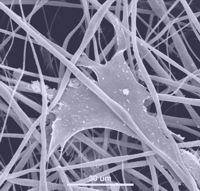1Department of Chemistry, and
2Medical School, Philipps-University, D-35032 Marburg, Germany
e-mail: dersch@staff.uni-marburg.de

| Roland Dersch1 U. Boudriot2, B. Goetz2, C. Wack2, Andreas Greiner1, J.H. Wendorff1
1Department of Chemistry, and
e-mail: dersch@staff.uni-marburg.de |
 |
Tissue engineering is a promising tool to manage structural and functional defects in bone and cartilage. To provide optimal conditions for a three-dimensional cell growth the use of a scaffold is necessary. Electrospinning is a method to produce micro- and nanofibers by application of high voltage to a polymer solution. We show the controlled fabrication of structured poly(l-lactide) fibers into two- and three-dimensional matrices which are biocompatible and biodegradable. These Matrices were seeded with human osteosarcoma MG-63 cells and cultivated for 14 days. Cells prefered clearly a guided growth along the nanofibers and demonstrated no signs of cell-death. Osteogenic differentiation of human mesenchymal stem cells onto a three-dimensional, nanostructured scaffold of electrospun poly(l-lactide) fibers is under investigation. Human mesenchymal stem cell were seeded onto this matrix and differentiated for 21 days.